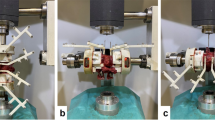Abstract
Purpose
The spine and pelvis coexist as a dynamic linked system in which spinal and pelvic parameters are correlated. Investigation of this system can inform the understanding and treatment of spinal deformity. Here, we demonstrate the use of motion capture technology to measure spine biomechanical parameters using a novel testing apparatus.
Methods
Three complete cadaveric spines with skull and pelvis were mounted into a biomechanical testing apparatus. Each lumbar vertebra was monitored by motion capture cameras as the spines underwent maximal anterior and posterior pelvic tilts about two sagittal axes at a controlled speed and applied force. These axes were defined as the sacral axis which passes transversely through the ilium and S1, and the acetabular axis which passes transversely through both acetabula. The experiments were repeated after L4–L5 fusion, and then, after both L4–L5 and T12–S1 fusion with pedicle screw instrumentation. Data were collected for total range of motion and for coupled translation at each functional spinal unit (FSU).
Results
Total range of motion and coupled translation within functional spinal units (FSUs) was decreased after spinal fusion. The displacement of each individual FSU was captured and summarized along with the observed patterns under each experimental condition.
Conclusion
Lumbar fusion decreases spinal motion in the sagittal plane in both overall ROM and individual coupled translations of lumbar vertebrae. This was demonstrated using motion capture technology which is useful for quantifying the translations of individual FSUs in a multisegmental spinal model.






Similar content being viewed by others
Availability of data and materials
Data are available upon request of the corresponding author.
Code availability
Not applicable.
References
Gonzalez-Blohm SA, Doulgeris JJ, Lee WE et al (2015) The current testing protocols for biomechanical evaluation of lumbar spinal implants in laboratory setting: a review of the literature. BioMed Res Int 2015:1–15. https://doi.org/10.1155/2015/506181
Metzger MF, Robinson ST, Svet MT et al (2016) Biomechanical analysis of the proximal adjacent segment after multilevel instrumentation of the thoracic spine: do hooks ease the transition? Glob Spine J 6:335–343. https://doi.org/10.1055/s-0035-1563611
Doulgeris JJ, Aghayev K, Gonzalez-Blohm SA et al (2013) Comparative analysis of posterior fusion constructs as treatments for middle and posterior column injuries: an in vitro biomechanical investigation. Clin Biomech 28:483–489. https://doi.org/10.1016/j.clinbiomech.2013.05.001
Hartmann F, Nusselt T, Maier G et al (2019) Biomechanical testing of different posterior fusion devices on lumbar spinal range of motion. Clin Biomech 62:121–126. https://doi.org/10.1016/j.clinbiomech.2019.01.012
Yu CC, Hao DJ, Ma YL et al (2016) The role of posterior longitudinal ligament in cervical disc replacement: an ovine cadaveric biomechanical analysis. Med Sci Monit Int Med J Exp Clin Res 22:1843–1849. https://doi.org/10.12659/msm.899138
Yu CC, Hao DJ, Huang DG et al (2016) Biomechanical analysis of a novel prosthesis based on the physiological curvature of endplate for cervical disc replacement. PLoS One 11:e0158234. https://doi.org/10.1371/journal.pone.0158234
Gajdosik R, Simpson R, Smith R et al (1985) Pelvic tilt. Intratester reliability of measuring the standing position and range of motion. Phys Ther 65:169–174. https://doi.org/10.1093/ptj/65.2.169
Posner I, White AA, Edwards WT et al (1982) A biomechanical analysis of the clinical stability of the lumbar and lumbosacral spine. Spine 7:374–389. https://doi.org/10.1097/00007632-198207000-00008
Panjabi MM, Takata K, Goel VK (1983) Kinematics of lumbar intervertebral foramen. Spine 8:348–357. https://doi.org/10.1097/00007632-198305000-00002
Bassani T, Galbusera F (2020) Statistics in experimental studies on the human spine: theoretical basics and review of applications. J Mech Behav Biomed Mater 110:103862. https://doi.org/10.1016/j.jmbbm.2020.103862
Panjabi MM, Brand RA, White AA (1976) Three-dimensional flexibility and stiffness properties of the human thoracic spine. J Biomech 9:185–192. https://doi.org/10.1016/0021-9290(76)90003-8
Patwardhan AG, Havey RM, Carandang G et al (2003) Effect of compressive follower preload on the flexion–extension response of the human lumbar spine. J Orthop Res 21:540–546. https://doi.org/10.1016/S0736-0266(02)00202-4
Panjabi MM, Krag M, Summers D et al (1985) Biomechanical time-tolerance of fresh cadaveric human spine specimens. J Orthop Res Off Publ Orthop Res Soc 3:292–300. https://doi.org/10.1002/jor.1100030305
Funding
No funding was received to assist with the preparation of this manuscript.
Author information
Authors and Affiliations
Contributions
Conception or design of the work: FA, JBM, SM, and SP. Data collection: FA, JBM, CWF, SM, and SP. Data analysis and interpretation: NB, SP, and FA. Drafting the article: NB and SP. Critical revision of the article: FA, NB, JBM, CWF, SM, and SP. Final approval of the version to be published, and agree to be accountable for all aspects of the work in ensuring that questions related to the accuracy or integrity of any part of the work are appropriately investigated and resolved: FA, NB, JBM, CWF, SM, and SP.
Corresponding author
Ethics declarations
Conflicts of interest
The authors have no conflicts of interest to declare that are relevant to the content of this article.
Ethics approval
The study utilized human tissue that was procured via the Department of Orthopaedics Anatomy Laboratory which provides de-identified samples. This study is deemed exempt by our IRB, because it is limited to cadaveric specimens. The Department of Orthopaedics Anatomy Laboratory protocols are in accordance with the ethical standards of our institution and with the 1964 Helsinki declaration and its later amendments and ethical standards.
Consent to participate
Informed consent for body donation for research and publication was obtained by Department of Orthopaedics Anatomy Laboratory.
Consent for publication
Informed consent for body donation for research and publication was obtained by Department of Orthopaedics Anatomy Laboratory.
Additional information
Publisher's Note
Springer Nature remains neutral with regard to jurisdictional claims in published maps and institutional affiliations.
Rights and permissions
About this article
Cite this article
Boroda, N., Pradhan, S., Forsthoefel, C.W. et al. Motion capture evaluation of sagittal spino-pelvic biomechanics after lumbar spinal fusion. Spine Deform 10, 473–478 (2022). https://doi.org/10.1007/s43390-021-00448-7
Received:
Accepted:
Published:
Issue Date:
DOI: https://doi.org/10.1007/s43390-021-00448-7




